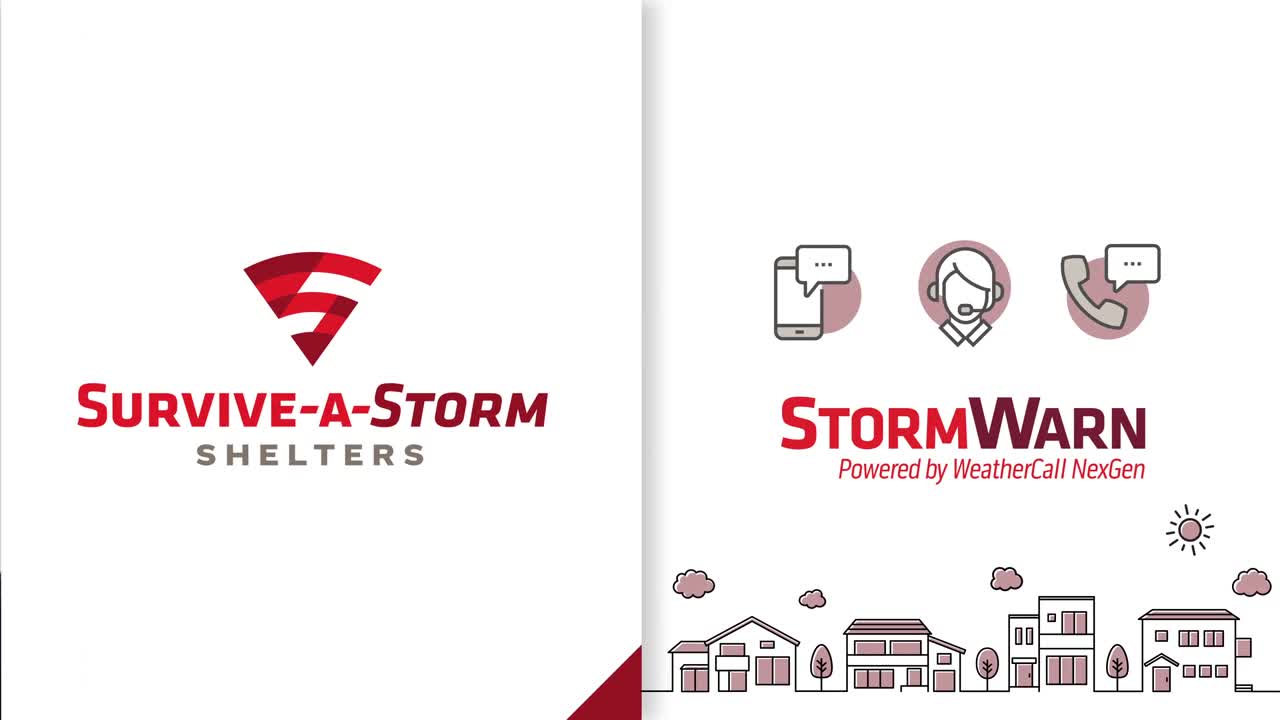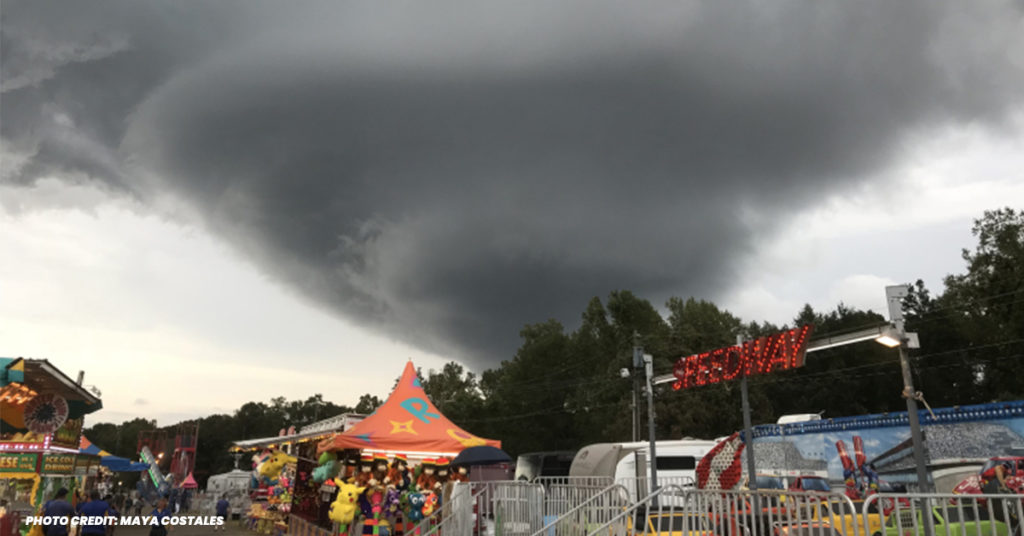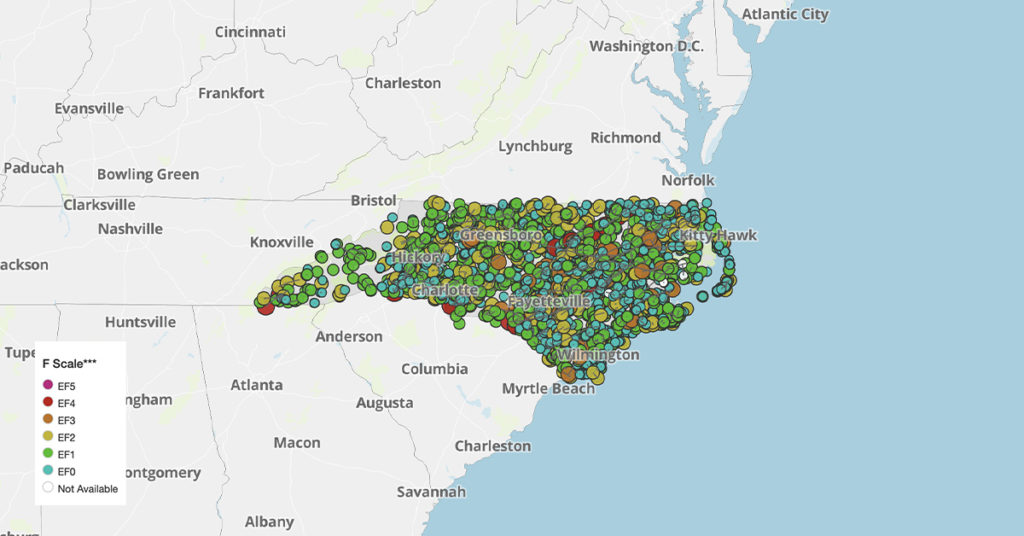North Carolina is located in what is known as "Dixie Alley," a region stretching from eastern Texas to the Carolinas that is particularly vulnerable to tornadoes, due to the coastal location, and the atmospheric conditions.
- Tornadoes are a common occurrence in North Carolina, with an average of 29 tornadoes per year recorded in the state between 1991 and 2020.
- The deadliest tornado in North Carolina history occurred on March 28, 1984, when a tornado outbreak swept across the state, killing 42 people and injuring over 1,000 others.
- Another notable tornado outbreak occurred on April 16, 2011, when 30 tornadoes touched down in North Carolina, causing 24 fatalities and more than 200 injuries.
- North Carolina's largest tornado outbreak on record occurred on April 16-17, 2011, when a total of 37 tornadoes touched down in the state.
- The most powerful tornado ever recorded in North Carolina was an EF-5 tornado that touched down on March 20, 1998, in the town of Oak Grove, killing two people and causing widespread damage.
- While tornadoes can occur at any time of year in North Carolina, the peak tornado season is from March through May, with a secondary peak in November.
- Tornadoes in North Carolina are most common in the eastern part of the state, particularly in the coastal plain region.
- North Carolina's earliest recorded tornado occurred in 1786 in the town of Edenton.
- Since reliable tornado records began in 1950, there have been over 1,000 tornadoes recorded in North Carolina, causing 120 fatalities and more than 2,600 injuries.
Documented North Carolina tornadoes since 1950

Know when severe weather is about to strike and when it's time for you to take shelter with our StormWarn texting program.

Preparing for Tornadoes in North Carolina
Tornadoes are a common and deadly natural disaster in North Carolina, making preparation critical. With an average of 29 tornadoes per year, the state is particularly vulnerable to these dangerous storms. Therefore, it is essential that individuals, families, and communities take the necessary steps to prepare for the possibility of a tornado.
One of the most crucial steps in tornado preparation is having a plan in place. The plan should outline how to communicate with family members or friends in the event of an emergency and how to stay informed about tornado warnings and alerts.
This plan should also include a designated safe space, such as a basement or interior room, where individuals can take shelter during a tornado. The safest place to be during a tornado is a residential tornado shelter or a designated community shelter. Tornado shelters, like those from Survive-A-Storm, are tested for safety by the Texas Tech Wind Institute, and use designs that follow the standards of the National Storm Shelter Association. Such tornado shelters are able to stand up to EF5 conditions.
In addition to having a plan, it is also important to have an emergency kit stocked with essentials such as food, water, first aid supplies, and important documents. This kit can help individuals and families be self-sufficient in the aftermath of a tornado and may help to alleviate some of the stress and anxiety associated with such a disaster.
Community preparedness is also critical in tornado-prone areas such as North Carolina. This can include educating residents about tornado safety and emergency preparedness, conducting drills or exercises to practice responding to tornado warnings, and ensuring that emergency responders and resources are in place to quickly and efficiently respond to any tornado-related emergencies.
Being prepared can save lives and reduce the impact of these devastating storms. By taking steps to prepare, individuals and communities can be better equipped to face the challenges that tornadoes bring.

Tornado Shelters Near Me in North Carolina
In North Carolina, public tornado shelters are typically located in designated community safe rooms, storm shelters, or designated public buildings. The best way to find public tornado shelters is to contact the North Carolina Department of Public Safety or your county officials. They should have information on the location of public tornado shelters in your area, as well as resources for emergency preparedness.
Additionally, you can contact the American Red Cross, which has two chapters that operate in the state, and several emergency shelters throughout North Carolina during tornadoes or other disasters. The Red Cross can provide information on the location of their shelters and any specific requirements or guidelines for accessing them.
It's important to note that public tornado shelters should only be used as a last resort and may have limited capacity. Individuals and families should have a plan in place for taking shelter in their own homes or in a nearby safe location, especially during times of high tornado activity.
North Carolina Tornado Safety Tips
Tornadoes can occur suddenly and without warning, making it essential to know what to do in the event of a tornado. The following tornado safety tips can help you stay safe during a tornado in North Carolina:
- Listen to local news and weather reports for updates on severe weather, including tornado warnings and watches.
- Develop a plan for where to go and what to do during a tornado. Identify a safe space in your home or a nearby shelter, and practice your plan with your family.
- If you are in a building during a tornado, go to the lowest level and seek shelter in an interior room, away from windows and doors. If you are outside, seek shelter in a sturdy building, or lie down in a low-lying area such as a ditch or culvert.
- Flying debris during a tornado can shatter windows and cause serious injuries. Stay away from windows and seek shelter in an interior room.
- If you are seeking shelter in a place outside of a designated tornado shelter, like an interior room, it could be helpful to use protective gear. If you have a bicycle or sports helmet, use it to protect your head during a tornado. Some experts also specifically recommend sheltering in an internal room that is a bathroom, since it is thought that the plumbing in the walls can add some structural integrity. This also affords you the opportunity to get into a bathtub and pull a mattress over the top. Though remember that, at best, this advice is anecdotal. The best place to be is in a designated tornado shelter.
- Keep track of the storm and listen for updates on the tornado's path and intensity. There are several ways to do this, like monitoring the weather for your area on TV or a weather radio. There are also location-based alert systems like StormWarn, that can tell you exactly when to take shelter from a tornado and will deliver an all-clear message when the situation has improved.
- Do not attempt to drive or walk through flooded or debris-filled areas, as they can be dangerous and unpredictable.
- Keep your emergency kit handy. Have a supply kit with essentials such as food, water, and first-aid supplies readily available.
By following these tornado safety tips, you can help protect yourself and your family during a tornado in North Carolina. It's important to stay vigilant and prepared for severe weather, particularly during tornado season, which typically runs from March through May.

North Carolina Tornado Shelter FAQs
Question: What types of buildings in North Carolina are designated as public tornado shelters?
Answer: Public tornado shelters in North Carolina may include schools, community centers, government buildings, and designated storm shelters. Some businesses may also have shelters that they open to the community during emergencies.
Question: How do I know if a tornado shelter in North Carolina is safe to use?
Answer: All public tornado shelters in North Carolina are required to meet safety standards and are inspected by the local authorities. You can also check for any posted signs indicating the shelter has been approved for use during a tornado.
Question: Are there any private tornado shelters available for individuals to purchase or rent in North Carolina?
Answer: Yes, there are private companies that provide tornado shelters for that include North Carolina in their delivery area. Survive-A-Storm is one such manufacturer and has both underground and above-ground shelters that are safety tested and designed to withstand tornadoes up to EF5
Question: What should I bring with me to a public tornado shelter in North Carolina?
Answer: One thing that you could prepare is a “go bag” that includes any necessary medications, a small first aid kit, a small amount of food and water, a radio, a flashlight, and any personal hygiene items. It's also important to wear comfortable clothing and shoes.
Question: How many tornado shelters are available for public use in North Carolina?
Answer: The number of public tornado shelters in North Carolina can vary by community. You can check with your local emergency management office or fire department for a list of available shelters in your area.
Question: Are there any specific guidelines or rules for accessing a tornado shelter in North Carolina?
Answer: Yes, there may be specific guidelines or rules for accessing a tornado shelter in North Carolina, such as requiring identification or limiting the number of people allowed inside. These guidelines can vary by community. As public spaces go, community shelters should be handicap accessible since they would fall under the rules of the ADA. Many people are also concerned with their pets during severe storms and that is something that you would need to contact the agency providing the shelter to find out if pets are allowed.
Question: What is the capacity of most tornado shelters in North Carolina?
Answer: The capacity of public tornado shelters in North Carolina can vary based on the size of the building and the available space. It's best to check with your local emergency management office or fire department for information about the capacity of the shelters in your area.
Question: Where can I find a map or list of tornado shelters in my specific North Carolina community?
Answer: You can check with your local emergency management office or fire department for a map or list of tornado shelters in your specific North Carolina community. The National Weather Service may also have information available on their website.
Question: Are there any cost or fees associated with using a public tornado shelter in North Carolina?
Answer: There are no fees or costs associated with using a public tornado shelter in North Carolina.
Question: How frequently are tornado shelters in North Carolina inspected and maintained?
Answer: Public tornado shelters in North Carolina are inspected annually to ensure they meet safety standards. They may also be inspected after severe weather events or other emergencies.


